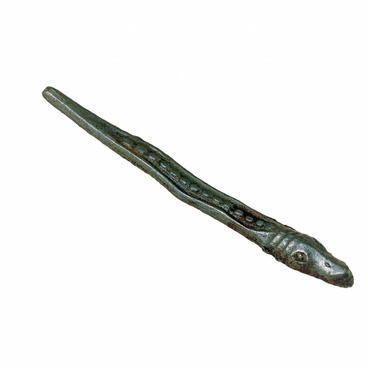The belt is considered to be one of the oldest accessories in history. Nobody certainly knows when this piece of clothing appeared, but researchers note that one can see the horizontal stripes which divided the human figure in the images of the Neolithic period. So they assumed that people could put a belt on already in the New Stone Age.
In the Middle Ages, a belt, in addition to its main function, replaced pockets: they appeared as a piece of clothing, presumably, only in the 15th century. The belt was fastened with a buckle, which was a part of the belt set. People attached a pouch or necessary items such as a drill bit, awl, scabbard, amulets, tinderbox (firesteel) to it. There were both male and female belts. Children up to about six or eight years old were not belted.
Belt was used in many cultures during wedding and funeral ceremonies. Belt sets in the burial graves indicated the social status and property status of the deceased. The belt, richly decorated with overlays, showed the man’s belonging to the warrior class. Belt decorations were made of gold, silver and bronze. Metal was chosen depending on the society status of the owner of the belt.
The set from the archaeological collection of the museum complex was found in 2005 during exploration works on a site of the Middle Ages — the village of Sorovskoye 26 on the Bolshoy Salym River 100 kilometers west of the city of Nefteyugansk. The artifact appeared in the museum funds in 2011.
The set includes six bronze elements, which are made in the technique of casting and forging. Plaques were attached to the belt with the help of pins — special spikes located on the reverse side. Metal objects in the Middle Ages came to the territory of the Nefteyugansk District mainly from those regions where metalworking was one of the main crafts. Only princes and their bodyguards could have such expensive items. Therefore, it can be assumed that a wealthy man from military class is buried in the grave discovered in 2005.
In the Middle Ages, a belt, in addition to its main function, replaced pockets: they appeared as a piece of clothing, presumably, only in the 15th century. The belt was fastened with a buckle, which was a part of the belt set. People attached a pouch or necessary items such as a drill bit, awl, scabbard, amulets, tinderbox (firesteel) to it. There were both male and female belts. Children up to about six or eight years old were not belted.
Belt was used in many cultures during wedding and funeral ceremonies. Belt sets in the burial graves indicated the social status and property status of the deceased. The belt, richly decorated with overlays, showed the man’s belonging to the warrior class. Belt decorations were made of gold, silver and bronze. Metal was chosen depending on the society status of the owner of the belt.
The set from the archaeological collection of the museum complex was found in 2005 during exploration works on a site of the Middle Ages — the village of Sorovskoye 26 on the Bolshoy Salym River 100 kilometers west of the city of Nefteyugansk. The artifact appeared in the museum funds in 2011.
The set includes six bronze elements, which are made in the technique of casting and forging. Plaques were attached to the belt with the help of pins — special spikes located on the reverse side. Metal objects in the Middle Ages came to the territory of the Nefteyugansk District mainly from those regions where metalworking was one of the main crafts. Only princes and their bodyguards could have such expensive items. Therefore, it can be assumed that a wealthy man from military class is buried in the grave discovered in 2005.



